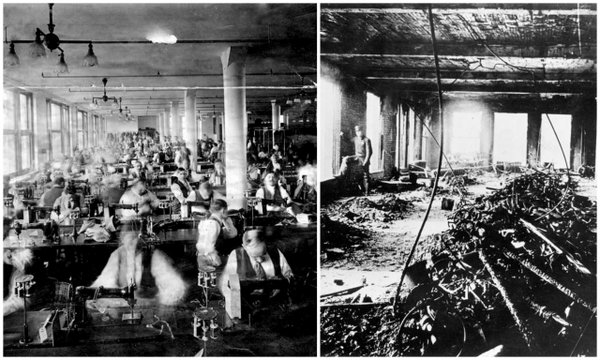Being a Slave Means More than Not Just Receiving Wages: It Means Your Life is Meaningless

This is New York Times Article on the Triangle Waist Company Factory Fire (the victims were sweatshop workers and were mostly Jewish women)
141 MEN AND GIRLS DIE IN WAIST FACTORY FIRE; TRAPPED HIGH UP IN WASHINGTON PLACE BUILDING; STREET STREWN WITH BODIES; PILES OF DEAD INSIDE
The New York Times, March 26, 1911
Three stories of ten-floor building at the corner of Greene Street and Washington Place were burned yesterday, and while the fire was going on 141 young men and women -- at least 125 of them mere girls -- were burned to death or killed by jumping to the pavement below.
The building was fireproof. It shows now hardly any signs of the disaster that overtook it. The walls are as good as ever; so are the floors; nothing is the worse for the fire except the furniture and 141 of the 600 men and girls that were employed in its upper three stories.
Most of the victims were suffocated or burned to death within the building, but some who fought their way to the windows and leaped met death as surely, but perhaps more quickly, on the pavements below.
All Over in Half an Hour.
Nothing like it has been seen in New York since the burning of the General Slocum. The fire was practically all over in half an hour. It was confined to three floors -- the eighth, ninth, and tenth of the building. But it was the most murderous fire that New York has seen in many years.
The victims who are now lying at the Morgue waiting for some one to identify them by a tooth or the remains of a burned shoe were mostly girls of from 16 to 23 years of age. They were employed at making shirtwaists by the Triangle Waist Company, the principal owners of which are Isaac Harris and Max Blanck. Most of them could barely speak English. Many of them came from Brooklyn. Almost all were the main support of their hard-working families.
There is just one fire escape in the building. That one is an interior fire escape. In Greene Street, where the terrified unfortunates crowded before they began to make their mad leaps to death, the whole big front of the building is guiltless of one. Nor is there a fire escape in the back.
The building was fireproof and the owners had put their trust in that. In fact, after the flames had done their worst last night, the building hardly showed a sign. Only the stock within it and the girl employes were burned.
A heap of corpses lay on the sidewalk for more than an hour. The firemen were too busy dealing with the fire to pay any attention to people whom they supposed beyond their aid. When the excitement had subsided to such an extent that some of the firemen and policemen could pay attention to this mass of the supposedly dead they found, about half way down in the pack, a girl who was still breathing. She died two minutes after she was found.
The Triangle Waist Company was the only sufferer by the disaster. There are other concerns in the building, but it was Saturday and the other companies had let their people go home. Messrs. Harris and Blanck, however, were busy and their girls -- and some men -- stayed.
Leaped Out of the Flames.
At 4:40 o'clock, nearly five hours after the employes in the rest of the building had gone home, the fire broke out. The one little fire escape in the interior was never resorted to by any of the doomed victims. Some of them escaped by running down the stairs, but in a moment or two this avenue was cut off by flame. The girls rushed to the windows and looked down at Greene Street, 100 feet below them. Then one poor, little creature jumped. There was a plate glass protection over part of the sidewalk, but she crashed through it, wrecking it and breaking her body into a thousand pieces.
Then they all began to drop. The crowd yelled "Don't jump!" but it was jump or be burned -- the proof of which is found in the fact that fifty burned bodies were taken from the ninth floor alone.
They jumped, they crashed through broken glass, they crushed themselves to death on the sidewalk. Of those who stayed behind it is better to say nothing -- except what a veteran policeman said as he gazed at a headless and charred trunk on the Greene Street sidewalk hours after the worst cases had been taken out:
"I saw the Slocum disaster, but it was nothing to this."
"Is it a man or a woman?" asked the reporter.
"It's a human, that's all you can tell," answered the policeman.
It was just a mess of ashes, with blood congealed on what had probably been the neck.
Messrs. Harris and Blanck were in the building, but they escaped. They carried with them Mr. Blanck's children and a governess, and they fled over the roofs. Their employes did not know the way, because they had been in the habit of using the two freight elevators, and one of these elevators was not in service when the fire broke out.
Found Alive After the Fire.
The first living victim, Hyman Meshel of 332 East Fifteenth Street, was taken from the ruins four hours after the fire was discovered. He was found paralyzed with fear and whimpering like a wounded animal in the basement, immersed in water up to his neck, crouched on the top of a cable drum, and with his head just below the floor of the elevator.
Meantime the remains of the dead -- it is hardly possible to call them bodies, because that word suggests something human, and there was nothing human about most of these -- were being taken in a steady stream to the Morgue for identification. First Avenue was lined with the usual curious east side crowd, Twenty-sixth Street was impassable. But in the Morgue they received the charred remnants with no more emotion than they ever display over anything.
Back in Greene Street there was another crowd. At midnight it had not decreased in the least. The police were holding it back to the fire lines, and discussing the tragedy in a tone which those seasoned witnesses of death seldom use.
"It's the worse thing I ever saw," said one old policeman.
Chief Croker said it was an outrage. He spoke bitterly of the way in which the Manufacturer's Association had called a meeting in Wall Street to take measures against his proposal for enforcing better methods of protection for employes in cases of fire.
No Chance to Save Victims.
Four alarms were rung in fifteen minutes. The first five girls who jumped did so before the first engine could respond. That fact may not convey much of a picture to the mind of an unimaginative man, but anybody who has ever seen a fire can get from it some idea of the terrific rapidity with which the flames spread.
It may convey some idea, too, to say that thirty bodies clogged the elevator shafts. These dead were all girls. They had made their rush their blindly when they discovered that there was no chance to get out by the fire escape. Then they found that the elevator was as hopeless as anything else, and they fell there in their tracks and died.
The Triangle Waist Company employed about 600 women and less than 100 men. One of the saddest features of the thing is the fact that they had almost finished for the day. In five minutes more, if the fire had started then, probably not a life would have been lost.
Last night District Attorney Whitman started an investigation -- not of this disaster alone but of the whole condition which makes it possible for a firetrap of such a kind to exist. Mr. Whitman's intention is to find out if the present laws cover such cases, and if they do not to frame laws that will.
GIRLS JUMP TO SURE DEATH. Fire Nets Prove Useless -- Firemen Helpless to Save Life.
The fire, which was first discovered at 4:40 o'clock on the eighth floor of the ten-story building at the corner of Washington Place and Greene Street, leaped through the three upper stories occupied by the Triangle Waist Company with a sudden rush that left the Fire Department helpless.
How the fire started no one knows. On the three upper floors of the building were 600 employes of the waist company, 500 of whom were girls. The victims -- mostly Italians, Russians, Hungarians, and Germans -- were girls and men who had been employed by the firm of Harris & Blanck, owners of the Triangle Waist Company, after the strike in which the Jewish girls, formerly employed, had become unionized and had demanded better working conditions. The building had experienced four recent fires and had been reported by the Fire Department to the Building Department as unsafe, on account of the insufficiency of its exits.
The building itself was of the most modern construction and classed as fireproof. What burned so quickly and disastrously for the victims were shirtwaists, hanging on lines above tiers of workers, sewing machines placed so closely together that there was hardly aisle room for the girls between them, and shirtwaist trimmings and cuttings which littered the floors above the eighth and ninth stories.
Girls had begun leaping from the eighth story windows before the firemen arrived. The firemen had trouble bringing their apparatus into position because of the bodies which strewed the pavement and sidewalks. While more bodies crashed down among them, they worked with desperation to run their ladies into position and to spread firenets.
One fireman, running ahead of a hose wagon, which halted to avoid running over a body, spread a firenet, and two more seized hold of it. A girl's body, coming end over end, struck on the side of it, and there was hope for an instant that she would be the first one of the score who had already jumped to be saved.
Thousands of people, who had crushed in from Broadway and Washington Square and were screaming with horror at what they saw, watched closely the work with the firenet. Three other girls, who had leaped for at a moment after the first one, struck it on top of her, and all four rolled out and lay still upon the pavement.
Five girls who stood together at a window close to the Greene Street corner held their places while a fire ladder was worked towards them, but which stopped at its full length two stories lower down. They leaped together, clinging to each other, with fire streaming back from their hair and dresses. They struck a glass sidewalk cover and crashed through it to the basement. There was no time to aid them. With water pour in upon them from a dozen hose nozzles the bodies lay for two hours where they struck, as did the many others who leaped to their deaths.
One girl, who waved a handkerchief at the crowd, leaped from a window adjoining the New York University Building on the westward. Her dress caught on a wire, and the crowd watched her hang there till her dress burned free and she came toppling down.
Many jumped whom the firemen believe they could have saved. A girl who saw the glass roof of a sidewalk cover at the first-story level of the New York University Building leaped for it, and her body crashed through the sidewalk.
On Greene Street, running along the eastern face of the building, more people leaped to the pavement than on Washington Place to the south. Fire nets proved just as useless to catch them and the ladders to reach them. None waited for the firemen to attempt to reach them with the scaling ladders.
All Would Soon Have Been Out.
Strewn about as the firemen worked, the bodies indicated clearly the preponderance of women workers. Here and there was a man, but almost always they were women. One wore furs and a muff, and had a purse hanging from her arm. Nearly all were dressed for the street. The fire had flashed through their workroom just as they were expecting the signal to leave the building. In ten minutes more all would have been out, as many had stopped work in advance of the signal and had started to put on their wraps.
What happened inside there were few who could tell with any definiteness. All that those who escaped seemed to remember was that there was a flash of flames, leaping first among the girls in the southeast corner of the eighth floor, and then suddenly over the entire room, spreading through the linens and cottons with which the girls were working. The girls on the ninth floor caught sight of the flames through the windows, up the stairway, and up the elevator shaft.
On the tenth floor they got them a moment later, but most of those on that floor escaped by rushing to the roof and then on to the roof of the New York University Building, with the assistance of 100 university students who had been dismissed from a tenth story classroom.
There were in the building, according to the estimates of Fire Chief Croker, about 600 girls and 100 men. The bodies of those killed and burned to death were found principally on the ninth floor, where over 50 perished in front of a closed doorway, which they had jammed shut; in the two elevator shafts 30 or more were piled up in the bottom after the elevator had ceased running; at the bottom of a single iron fire escape in an air shaft in the building's rear and on the fire-proof stairways between the eighth and ten stories, up which the fire from the burning sewing machines on the eighth floor went with a rush of air toward the roof.
When the Fire Was Discovered.
Samuel Bernstein, the waist factory's foreman, and Max Rothberg, his first assistant, were standing together on the eighth floor when the screams of girls attracted their attention to the southeast corner of the large room. They rang for the elevators, of which two were in the south side of the building, and Rothberg telephoned to the Fire Department and Police Departments. Two hundred girls were working on that floor, most of them still at their machines in the narrow aisles that gave them hardly room to move about. Dynamos used to operate the sewing machines were in the corner from which the fire was spreading.
The two men attacked it with buckets of water, feeling confident at first they would be able to put it out. In the meantime the girls, screaming loudly and in a panic, rushed for the elevator shaft and the staircase, where they encountered a closed door.
Dora Miller of 10 Cannon Street got the door part way open, but it was jammed shut again by the press of people behind her. She struck a glass panel in it with her firsts until she had made a hole large enough to climb through, and she escaped. Twenty others followed her before the flames reached them, and the rest of those caught on the floor were only discernible as a mass of charred bones when the firemen at last worked their way up the staircase.
Bernstein and Rothberg escaped by way of the elevator on its last trip to the floor.
Factory Owners Escape.
The two partners, Harris and Blanck, were both in the building, Harris being on the ninth floor and Blanck on the eighth. with Blanck, according to a statement of Joseph Zito, an elevator man, were his two daughters and a governess. He was telephoning for a taxi-cab to take them home when the alarm was sounded.
Blanck told Zito, the latter declares, to keep his elevator running and take out the women first.
The two passenger elevators, in charge of Zito and another operator named J. Gaspar, made several trips, but never went above the eighth floor as they found more than enough people surrounding the entrance on that floor each time they reached it.
One of the men -- which one was not made clear in the various versions of the affair offered -- deserted his elevator and ran away, crying "Fire" as he ran.
Max Steinberg, a New York University law student, saw him running through Washington Place, and at the same time saw a girl leap from an eighth story window. He pulled a fire alarm box in Washington Square East and then ran to the building, where he entered the deserved elevator and ran it for four more trips before the heating of the cables put it out of commission.
Trapped on the Ninth Floor.
On the ninth story, which like the eighth was filled with sewing machines and was used for cutting and sewing shirtwaists, the girls fared worse than those on the floor below. They crowded about the elevator shaft, but no cars responded to their frantic ringing of the bell. Time after time they saw the cars approach, only to be filled at the eighth and go down again.
Girls who rushed to the staircase were met with flames which bore them down before they could retreat. Those who reached the windows and waited there for firemen saw the ladders swing in against the building two stories below them.
The one little iron fire escape, leading from a rear window, was pitiably inadequate, and it was from this floor that most of those came who fell like paper dolls, end over end, to the pavement.
There were about 20 men on the ninth floor. Calmer than the girls, they lined the southerly tier of the windows first and tried to force the girls back to prevent them from jumping. Several girls they dragged back, after they had reached the window sills, and some they induced to lift themselves in again after they had climbed outside and were clinging only with their hands.
Zito, the elevator man, said that on his last trip down he could hear the thud of bodies striking the roof of his car as women jumped from the ninth floor after giving up hope that he would reach them. He heard the rattle of silver from their pay envelopes as it came through the iron grating into the car.
The loss on this floor was not known to the firemen and police until nearly 7 o'clock, when Deputy Fire Chief Binns reached it on the concrete stairway, which remained perfectly solid and unharmed. Binns found the bodies of fifty or more women, those hwo had not been burned beyond recognition seeming to be mere girls. They were lying in heaps upon the floor, as if they had huddled together near the stairway and the elevator shaft, and had been overtaken there by the flames. Money from the pay envelopes was strewn about close to them.
The tenth floor rushed for the roof. The smoke issuing from the windows was seen by Prof. F. Somner, who was teaching twenty-five young men the principles of the New Jersey Code on the tenth floor of the law school.
Prof. Somner ordered his students to rush to the roof and lower ladders to the roof of the factory building. The New York University building is one story higher than the waist factory building. One ladder was procured and a student named Kremmer descended on it to the roof of the building on fire. Another student, at the top of the ladder, grasped the women as they climbed toward the top, while Kremmer kept them from blocking the bottom rungs.
Men, panic-stricken, fought with the women to get to the ladder, but Kremmer shoved them away and let the women out of the danger zone first. Over 100 women and 20 men escaped this way. Another hundred reached a building north of the burning one, whose roof was only five feet higher and could be reached without a ladder.
How many reached the streets through the stairways nobody knew, as they were foreigners who spoke little English and fled for their homes in the lower east side as soon as they gained the sidewalk.
The task of the police and firemen outside the building was hardly started before the fire had caused its full damage in the loss of life. The three burned stories, after it was all over and Fire Department searchlights played upon them, were seen to be wholly intact except for their wooden window trim and wooden floor coverings. Red tiling flashed the searchlight glow back to the street below from all the ceilings, and steel and concrete layers made the floors as firm to the tread of the firemen as if they had been newly built.
Police and Firemen Arrive.
The call to the police reached Headquarters over the telephone in a brief message that said girls were jumping from the Triangle Waist Company windows. The police were familiar with the place, as it had played a centre role in the opening phases of the shirtwaist strike.
Headquarters, from First Deputy Commissioner Driscoll and Chief Inspector Schmittberger to the last clerk and doorman, emptied itself, at Driscoll's orders, into the fire zone. Inspector Daly and twelve Captains reported to Schmittberger a few moments after he arrived.
Capt. Dominick Henry of the Mercer Street Station had preceded Driscoll and Schmittberger, and was attempting to establish fire lines when they arrived. Twenty-five patrol wagons from all the downtown precincts and 150 men came into the fire zone. They made one line on Washington Square East, forcing the people to the west side of the street, another line at Broadway, and cross-street lines at Waverly Place and on Fourth Street.
The second, third and fourth fire alarms were turned in before any apparatus had appeared, on the receipt of information at Fire Headquarters that there were twenty or more dead on the sidewalks. Chief Croker arrived in time to see his men spreading hopelessly their small and one or two large life nets, and saw many jump to their deaths.
Ambulances from Bellevue and New York and St. Vincent's Hospital -- twenty or more in number -- lined the street in Washington Square East and in Washington Place.
Ten surgeons from Bellevue, under Drs. Byrne, Read, and Kempf, threaded their way among the firemen, gathering up the dead. They worked at this task from 6 o'clock until 7, and then policemen came to their assistance. The bodies found on Greene Street were taken to the east sidewalk, while those in Washington Place were laid in lines on both sidewalks.
Tarpaulins, laid over them, protected them somewhat from the deluge of water which, pouring from the high-pressure towers like a miniature Niagara, flowed down the side of the building and into foot-deep flood along the pavement.
The surgeons could offer little aid except to cover the bodies of the dead. Here and there from near-by stores reports came of injured, and a few ambulances drove away with these to the hospitals. Mostly all there was to do was to determine that life was extinct in the bodies on the pavement, and cover them over.
Deputy Police Commissioner Driscoll sent in an order at 6:30 o'clock for seventy-five coffins, and later another order for seventy-five more. It was not known to the firemen and policemen at first that the death roll would reach anything like its final proportions.
How Many Died.
A thirteen-year-old girl hung for three minutes by her finger tips to the sill of a tenth floor window. A tongue of flame licked at her fingers, and she dropped to death.
A girl threw her pocketbook, then her hat, then her furs form a tenth-floor window. A moment later her body came whirling after them to death.
At a ninth-floor window a man and a woman appeared. The man embraced the woman and kissed her. Then he hurled her to the street and jumped. Both were killed. Five girls smashed a pane of glass, dropped in a struggling tangle, and were crushed into a shapeless mass.
A girl on the eighth floor leaped for a fireman's ladder, which reached only to the sixth floor. She missed, struck the edge of a life net, and was picked up with her back broken. From one window a girl of about 13 years, a woman, a man, and two women with their arms about one another threw themselves to the ground in rapid succession. The little girl was whirled to the New York Hospital in an automobile. She screamed as the driver and a policeman lifted her into the hallway. A surgeon came out, took one look at her face and touched his hand to her wrist.
"She is dead," he said.
One girl jumped into a horse blanket held by firemen and policemen. The blanket ripped like cheesecloth, and her body was mangled almost beyond recognition.
Another dropped into a tarpaulin held by three men. Her weight tore it from their grasp and she struck the street, breaking almost every bone in her body.
Almost at the same moment a man somersaulted down upon the shoulder of a policeman holding the tarpaulin. He glanced off, struck the sidewalk, and was picked up dead.
Chief Croker thought at first it would not go over twenty-five. Then he placed the number at sixty-five -- the total on the streets and reported from the inside. At 7 o'clock, over two hours after the firemen had come, the dead on the ninth floor were found, and those in the elevator shaft, each find sending the total up beyond the largest estimates previously made.
In getting out the bodies, the task proved so formidable that it was late in the night before it was reasonably complete.
Taking the Bodies Away.
Coroner's Physician O'Hanlon, with Coroners Holtzhauser and Lehaene, arrived at 6:45 o'clock along with District Attorney Whitman and several of his assistants. O'Hanlon explained that he had cared for the dead from the Slocum disaster on the recreation pier, and it would be better to handle these in the same manner, as the Morgue would prove hopeless in the task of accommodating them. He said he had still some of the tags such as were used in the Slocum disaster, and he proposed that each body be tagged exactly where it lay, and that records be made by number. He was told by Coroner Holtzhauser to proceed in this manner, and did so with the assistance of 100 or more policemen.
As fast as bodies had been looked over for identifications and tags fastened to them, coffins were brought from a supply depot established in East Washington Place. In these rude wooden boxes, coverless, the bodies were placed in patrol wagons and driven away.
At 7:45 o'clock the searchlights from four Fire Department engines were playing in the upper windows, and a glow came out of them from torches carried within by firemen. Suddenly a black shadow swung out of the ninth-story window, and the creaking of pulleys and a rope and tackle began, as the black mass descended speedily toward the ground. Firemen in windows on the lower floor guided the ropes. It was the beginning of the work of bringing out the bodies from the floor where the death roll was the largest.
The pulley system worked for an hour, each body being lowered after it had been wrapped in black cloth and tied securely until it resembled just such packages as go up and down daily in the business district, rope-and-pulley fashion.
Coroner's Statement.
The scene was more than Coroner Holzhauser could stand. Sobbing like a child, the Coroner, who was first to open the fireplace where Ruth Wheeler's body was incinerated in the Wolter flat, said that that scene was easy to stand compared with this.
"And only one miserable little fire escape!" he said. "I shall proceed against the Building Department along with the others. They are as guilty as any. They haven't been insistent enough, and these poor girls who were carried up in the elevator to work in the morning -- now they have come down on the end of a rope."
That investigations from many centres would be started was early made apparent. Building Department officials who arrived at 7:20 o'clock, said they would begin one this morning. Fire Marshal Beers said he would begin another. The District Attorney made a list of witnesses that he will question.
Chief Croker's View.
Fire Chief Croker, after the fire had flickered down to a few embers still glowing here and there, spoke vigorously against the men who have opposed his plans for better fire protection. "Look around everywhere," he said, "nowhere will you find fire escapes. They say they don't look sightly. I have tried to force their installation, and only last Friday a manufacturers' association met in Wall Street to oppose my plan and to oppose the sprinkler system, as well as the additional escapes."
"This is just the calamity I have been predicting," said Chief Croker. "There were no outside escapes on this building. I have been advocating and agitating that more fire escapes be put on factory buildings similar to this. The large loss of life is due to this neglect."
He said that there was only one fire escape from the building. An old-time perpendicular affair, he said, leading to the courtyard in the centre of the block of buildings, which would only allow of one person's escape at a time. When he examined this escape, he said, he found on the upper floors that it had become very loose, and it was a dangerous matter to escape by that route.
"A repetition of this disaster is likely to happen at any time in similar buildings," he said. He advocated balcony fire escapes with a wide iron staircase.
The staircases in the building, the Chief said, were of the ordinary three feet six inches wide type, but he believed that if escape had been sought by that route, the death list would not have been so appalling.
There were rumors that the fire started by a gasoline explosion, but the survivors said that they had heard no explosion.
Fire Commissioner R. Waldo being out of town yesterday, the fire was in charge of Deputy Commissioner Arthur J. O'Keefe, in charge of Brooklyn and Queens, who is taking the Commissioner's place.
He and Coroner Holtzhauser had a dispute concerning the cause of the fire at 11:20 o'clock. Holtzhauser remarked that there was a terrible responsibility for the Fire Department to meet.
"And for some other departments, too," O'Keefe replied. "Commissioner Waldo to my certain knowledge had reported this place to the Building Department within the past three months as a building unsafe for use as a factory, since there were insufficient means of egress by stairways, and there were not sufficient fire escape facilities.
"Oh, that makes a difference, then," Holtzhauser concluded.
Winfield R. Sheehan, Commissioner Waldo's secretary, joined the group at that juncture. He said that he personally had mailed the protest to the Building Department and knew of Commissioner Waldo's anxiety because of the unsafe condition of the building and his inability to force the making of changes.
Alfred Ludwig of the Department of Buildings was acting in the capacity of Superintendent during the absence of Supt. Rudolph P. Miller, who was out of town last night.
The building which was burned, it was said by one of the members of the department who stands near to the Commissioner but who refused to be quoted, was one of several thousand which had been recommended by the Fire Department for additional fire escapes.
"These recommendations," said the official, "were made several weeks ago after a thorough investigation by members of the Fire Department of all office, manufacturing, and loft buildings in the five boroughs. These investigations were made by the Fire Department at the request of Commissioner Waldo, although according to law this department had no control over the construction and means of escape on the many large factory buildings in the city.
"There was not one building in the city which escape the eyes of the Fire Department, each place being investigated by the foreman of the engine company in the district in which it was situated.
"The investigation lasted weeks, and after a report had been made to the Commissioner it was forwarded to the Building or the Tenement House Department. Many of the recommendations which were made by the Commissioner were at once attended to, but this one seems to have been neglected."
Fire Chiefs and others connected with the department seemed to believe that the large loss of life could not have been avoided had the operators not become panicstricken. The work of the elevator men was spoken of by members of the department with praise, who seem to think had they not kept their heads the total loss of life might have been doubled.
The building, Chief Croker said, was all that could be wished for in the way of fireproof construction. "But it isn't the building that's going to give us fireproof conditions," Croker said to the dripping firemen and others crowded around him. "The lesson of the fire is that a building is just as fireproof as the stuff within it -- fireproof walls, fireproof floors, and fireproof stairways -- then rooms packed with flimsy cloth and trimmings and ran by electric dynamos about which waste and oil were allowed to accumulate."
The Edison Company strung lights between 8 and 9 o'clock through every floor in the building, to aid the firemen in their search for bodies.
The cloud of smoke from the fire was visible in all parts of Manhattan. It rose straight in the air above the roof, and then for a time between 5 and 6 o'clock tongues of flame illumined the darker mass above. The firemen could not reach it with their hose streams, and even the high pressure towers had difficulty in throwing their streams above the ninth floor. No water went over the roof until firemen made their way up the staircase after the fire fighting had become a matter of detail and small burning sections.
It leaped across and open areaway into the New York University Law School, destroying the Faculty room and damaging two classrooms. Students carried many valuable books to safety out of the library and helped with buckets to wet down woodwork that was beginning to smoke in the intense heat.
Nowhere in the building except on the three upper floors were people at work. The other concerns in the building had dismissed their forces at 3 o'clock, and only the shirtwaist makers were continuing their work. These were Meyer, Crows & Wallace, clothiers, on the sixth and seventh floors; Morris Blum, clothier, on the fifth and sixth floors; Harris Brothers, clothiers, on the third and fourth floors, and the Hatters' Exchange, and Martin Bates, Jr., on the first and second floors.
The superintendent of the building, who refused to give his name, or identify himself other than that he was employed by J. J. Asch of 735 Broadway, the owner, said there were two freight elevators in the rear on which the owners had partly depended to get the shirt waist makers out in case of fire. Whether anyone had tried to use then, or if anyone had come down on them he did not know.
The building was roped off at 10:30 o'clock, and the police lines withdrawn, except for the streets immediately surrounding it.
Relatives of the dead were not allowed to come near while the work of the firemen and surgeons was going on, but were taken under police escort to the Mercer Street Station, where a vast crowd congregated throughout the evening. Broadway at 11 o'clock, in the vicinity of Washington Place, was thronged with women, walking up and down and wringing their hands while calling the names of their kinfolks whom they had lost.
SCENES AT THE MORGUE. Men and Women Gather in a Frantic Throng in Quest of Loved Ones.
A few minutes after the first load of fire victims was received at the Bellevue Hospital Morgue the streets were filled with a clamoring throng, which struggled with the reserves stationed about the building in an effort to gain entrance to view the bodies of the dead in the hope of identifying loved ones.
The frantic mob was reinforced as the hospital wagon brought more of the dead to the institution. The sobbing and shrieking mothers and wives, and frantic fathers and husbands of those who had not been accounted for struggled with the police and tried to stop the wagon that was bearing the dead on its trips to the Morgue. Mothers and wives ran frantically through the street in front of the hospital, pulling their hair from their heads and calling the names of their dear ones.
A few of the surging mob who viewed the situation in a calmer manner attempted to calm the excited ones, but in vain. The police were abused because they would not allow the surging mob in the Morgue, and in many instances they were threatened and had to resort to the use of their nightsticks to keep the struggling mass from breaking in.
Two members of the throng who succeeded in gaining entrance to the Morgue were Mrs. Josephine Pannel of 49 Stanton Street and her son-in-law, who came in search of her daughter, Mrs. Jane Bucalo, 18 years old. She was last seen struggling to get into the elevator on the eighth floor of the building. Mrs. Pannel walked up and down the aisle that was formed between the rows of the unidentified dead and looked in vain for her daughter.
She was filled with hope, however, when an attendant announced that the wagon had just arrived with another load of the fire victims. The newly arriving dead were brought into the Morgue and stretched out, and Mrs. Pannel and her son-in-law ran frantically up and down the lines trying to find the one they sought. When the mother found that her search was in vain, she ran shrieking to her son-in-law and began tearing out her hair. Bucalo stood as a man in a trance, gazing at the rows of blackened bodies. Suddenly he reeled and fell to the floor. He was assisted to his feet by the attendants.
Presently Mrs. Pannel became calmer, and, seeing that there was no body among the dead that would answer the description of her daughter, she grew more composed, and thought it was probable that her daughter had escaped from the burning building alive.
At the door of the Morgue Mrs. Pannel met a reporter, and told him of her miraculous escape from the burning building, and the cause of her frantic search for the body of her daughter. According to her story, she was in the reading room of the factory when the fire was discovered. She, with others, ran to the elevator shaft, and when the car reached the eighth floor they fought to get into it. She said that she seized her daughter by the skirt before leaving the cutting room, and as she was being carried into the elevator by the frantic mob that was surging behind her, her hold on her daughter's dress was torn away, and she remembers seeing the terrorized face of her daughter as the car was started downward. She called to her daughter, and thought that she saw her reel and fall to the floor as the car shot downward.
Mrs. Pannel described graphically the surging throng that clamored in the hall of the eighth floor and the struggle of the employes to gain entrance to the elevator car. She told of the rush of the occupants of the car when the elevator reached the ground floor on its last trip. She said she had a dim recollection of persons being trampled under foot by the excited mob as they dashed from the car to the entrance of the building, and that she believed many who were trampled upon perished in the bottom of the elevator car.
She also said that when the car left the eighth floor, some of the employes made a vain attempt to leap on the top of the car and that a few, being pushed forward by the struggling mass behind them, fell down the shaft on the eighth floor and were dashed to death upon the roof of the car.
Police Work Desparately.
A hundred policemen, most of them ashen and with trembling lips, worked at the heart-rending task of keeping back, without undue roughness, the maddened thousands.
"For God's sake," one cried to a reporter, who was wedging his way out of the mob, "get me a drink."
The poor bluecoat needed it.
Every few minutes a patrol wagon or a hastily improvised morgue wagon that had done duty as an auto truck earlier in the day appeared at the head of the mob at First Avenue and Twenty-sixth Street, and the reserves of six precincts had to force open a narrow path through the crowd for it. As soon as the path was opened in front, however, the crowd surged in behind it. At the sight of the bodies the crowd broke into fresh weeping and screaming, each seeming to see in the charred and often unrecognizable remains a loved one.
Twelve patrol wagons from as many stations, besides dozens of hastily impressed dispensary wagons of the Police Department and the Department of Public Charities and a few auto trucks were used in transporting the dead from the fire to the Morgue. The Morgue itself became too crowded, early in the evening, for further storage of bodies, and the Charities Department decided to throw open the long public dock adjoining in. Here, as night settled over the city, the bodies were taken from the wagons and laid out, side by side, in double rows along either side of the long docks.
Besides the thirty attendants regularly at the pier, twenty derelicts who had applied at the Municipal Lodging House in East Twenty-sixth Street for a night's rest, were pressed into service for the ghastly work.
In the narrow lane left between the double rows of the dead on the dark pier, the patrol wagons and rude dead wagons crept slowly to where the lines had freshly ended. They deposited their freight, backed slowly out, and returned to the scene of the fire for more bodies.
As fast as the dead where brought to the pier the grimy panhandlers and derelicts were set to work arranging them in rows, and later putting them in the rough wooden boxes that serve as coffins nightly at the Morgue. Bu the supply of boxes was soon exhausted, and Commissioner Drummond of the Department of Charities was obliged to send over to the storage warehouse on Blackwell's Island for more. Presently, there steamed up to the pier from the island a large double-decked launch, bringing stacked up on its deck 100 more boxes.
"Them boxes wasn't brought here since the Slocum fire," said one old attendant at the Morgue, amid a tense silence. Other attendants nodded reminiscently.
Considerable confusion was caused on the pier in numbering the dead. The police of the various precincts had received from the Charities Department small, colored tags bearing numbers to tag the different boxes as soon as the bodies were laid in them. There turned out to be three separate systems of numbers, and the enumeration had to be done all over again.
At 11:30 o'clock, with the mob still storming more and more outside, the police had counted in the Morgue and on the pier 136 bodies -- thirteen men and 122 women. Fifty-six of these were burned beyond all but human semblance and may never be identified. The thousands of clamorers outside could not have identified them, even if the police had left them swarm in on the pier.
As the maddened throng swarmed around the ghastly laden patrol wagons and improvised hearses their misery wrung even the hardened habitual handlers of the dead in the Morgue, making them frequently turn away from their work. There were hundreds scantily clad and shivering, despite their raving, in the cold night air. Many of them had no money. Their week's funds were in the pay envelopes, found in dozens, on the scorched and irrecognizable bodies on the pier. One woman, her head charred to a mere twisted blurr of black, carried in her stocking $600 in tightly crumbled bills. Dozens of girls whose bodies were laid out on the pier were found to have carried their scant savings in this way.
Clung Together in Death.
Two girls, charred beyond all hope of identification, and found in the smoking ruins with their arms clasped around each other's necks, were conveyed to the pier, still together, and placed in one box.
Horrible cries had burst from the misery stricken mob outside when these two were carried through the narrow ane in the street, and a few of the clamorous throng had forced their way to the wagon and lifted the dark tarpaulin. Everywhere burst anguished croes for sister, mother, and wife, a dozen pet names in Italian and Yiddish rising in shrill agony above the deeper moan of the throng.
Now and then a reporter, the way cleared before him by a broad, white-faced policeman, forced his way to the nearest telephone, to send to his office a report of what was happening there. Each time a hundred faces were turned up to him imploringly, and a hundred anguished voices begged of him tidings of those within. Had he seen a little girl with black hair and dark-brown cheeks? Had he seen a tall, thin man, with stooped shoulders? Could he describe any one of the many he had seen in there? The poor wretches were hunting for a "story," too.
Piteously they pleased with the policemen to let them -- only them -- past, so that they might see whether their loved ones were on the pier. They would only look around, one short glance, and come straight out. The policemen, struggling with their own emotions more roughly than with the crowd, could only put them off. Presently, they said, in a very little while now, they would let them all in.
When finally the pleadings and struggles of the anguish-wracked multitude bade fair to drive them through all lines in a hungry swarm over the pier and into the Morgue, Inspector Walse, Capt. Cray of the East Thirty-fifth Street Station, Commissioner Drummond, his Deputy, Frank J. Goodwin, and Coroners' Physicians Weston and O'Hanlon held a hurried consultation behind the barred doors of the Morgue. They decided to number each body anew, to make sure of the count; to turn over the valuables or money found with the bodies to Lieut. Sullivan for safekeeping, anad then to let the throng, in small parties, into the place. As soon as a body was identified they would place the lid on the coffin and remove it to one side.
The mere announcement, spreading through the crowd outside, that the police would let them through and open the doors at midnight threw the mob into a wild hysteria of almost joy. Several women had to be taken to Bellevue for treatment, laughing and crying and struggling all the way.
Inside, as they heard the savage cries of the mob, they sickened and paled at the thought of what would follow when the door were opened.
"Fifty-six!" muttered Inspector Walsh, turning his face away. They call him "Smiling Dick" Walsh, but his averted face was not smiling. He meant the fifty-six bodies that were burnt or crushed beyond recognition; fifty-six that would certainly be buried in unnamed graves. Dozens of them had every stitch of clothing burned off them. One body -- that of a young girl -- was headless and burned to a crisp.
Commissioner Drummond realized that when the mad throng was let into the Morgue and on the pier, many of them, already crazed by uncertainty concerning their loved ones, might at the sight of the dead throw themselves into the river. He therefore ordered that every opening in the Morgue building and on the covered pier be boarded up at once, and that no space should be lift which would permit the passage of a body.
At midnight, by order of Capt. Gray, the door of the Morgue was opened for a brief moment, and the foremost of the surging mob outside, to the number of fifteen, was allowed to enter. The police squad at the doors could hardly keep the rest back, with promises of letting them, too, presently enter in groups of fifteen.
Each group, shivering and clamoring and weeping, was lined up at the door and allowed slowly to file between the rows of boxes. Two policemen accompanied each of them, ready to support them if they should faint. They looked around with an air of frightened bewilderment at the ghastly array of dead, and then, one by one, looking down at the nearest box at their feet, where the mangled bodies lay, with heads propped up on boards for the light of the attendant beside the box, they collapsed with cries of terror. Such were carried to one side and revived by physicians from Bellevue, and later warmed with coffee handed to them by attendants and panhandlers at the pier.
Scores of men and women thought they saw in the ghastly bodies propped up in the boxes the relatives they were looking for, but could not identify them positively.
Around several bodies gathered men and women in small knots, each insisting pitifully that what was propped up there belonged to them, and calling the unrecognizable mass with tender pet names.
One man, William Mantes of 35 Second Avenue, came there seeking for his sister Sarah, aged 15; his sister Lucy, 19 years, and his mother, all of whom had worked in the same shop. He couldn't find any of them and broke down completely. Another, Dominick Leone, of 444 East Thirteenth Street, came to find three cousins and a niece, who hadn't returned home. He did not find them.
At 1 A.M. eight bodies had been identified by relatives and set aside in sealed boxes. The relatives filed into the improvised Coroner's office in the morgue and tearfully stood in line for their slips, permitting them to have the bodies removed. There was a competitive mob of undertakers with their wagons at the outskirts of the crowd ready to do that.
Inspired to create
your own Haggadah?
Make your own Haggadah and share with other Seder lovers around the world
Have an idea
for a clip?
People like you bring their creativity to Haggadot.com when they share their ideas in a clip
Support Us
with your donation
Help us build moments of meaning and connection through
home-based Jewish rituals.
OUR TOP CONTRIBUTORS
Passover Guide
Hosting your first Passover Seder? Not sure what food to serve? Curious to
know more about the holiday? Explore our Passover 101 Guide for answers
to all of your questions.






















